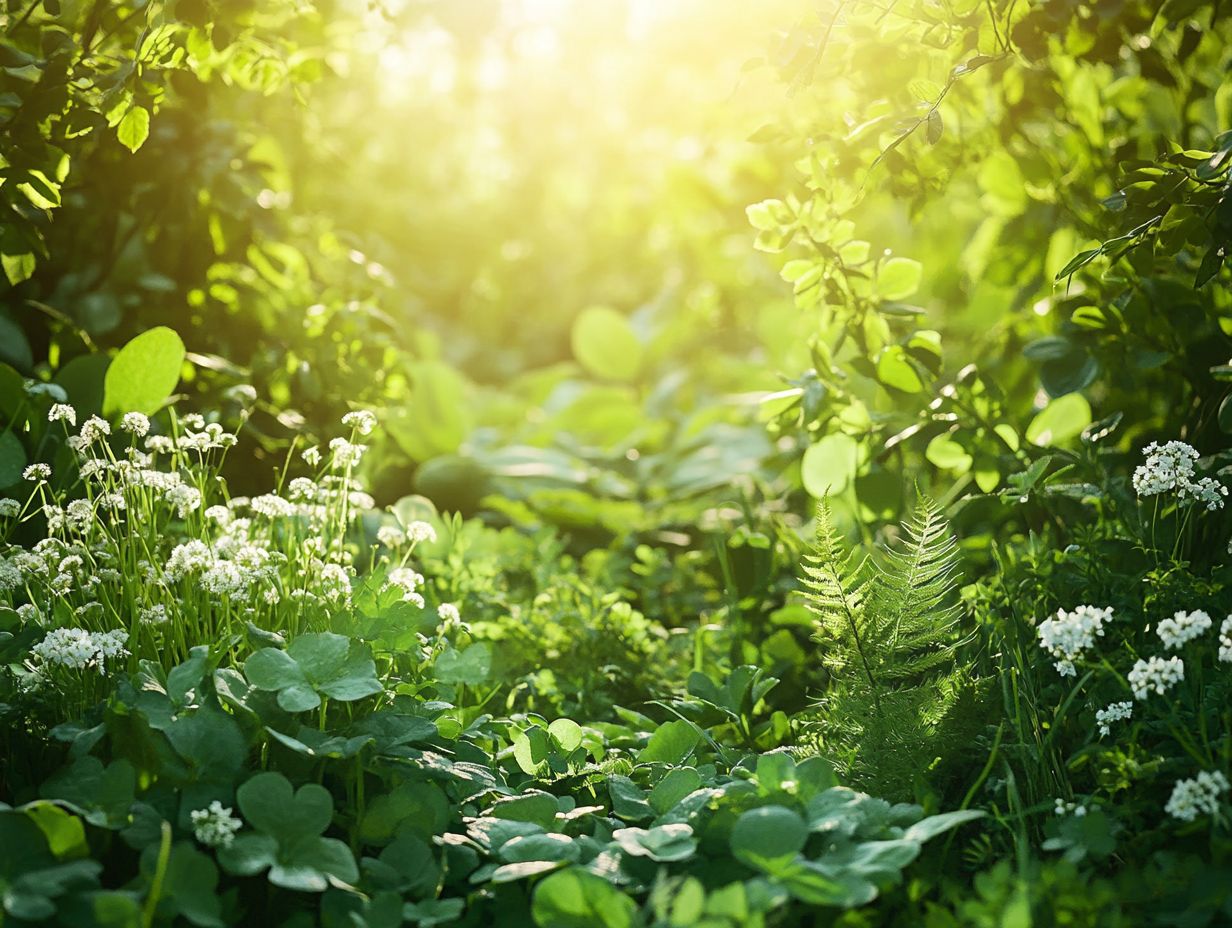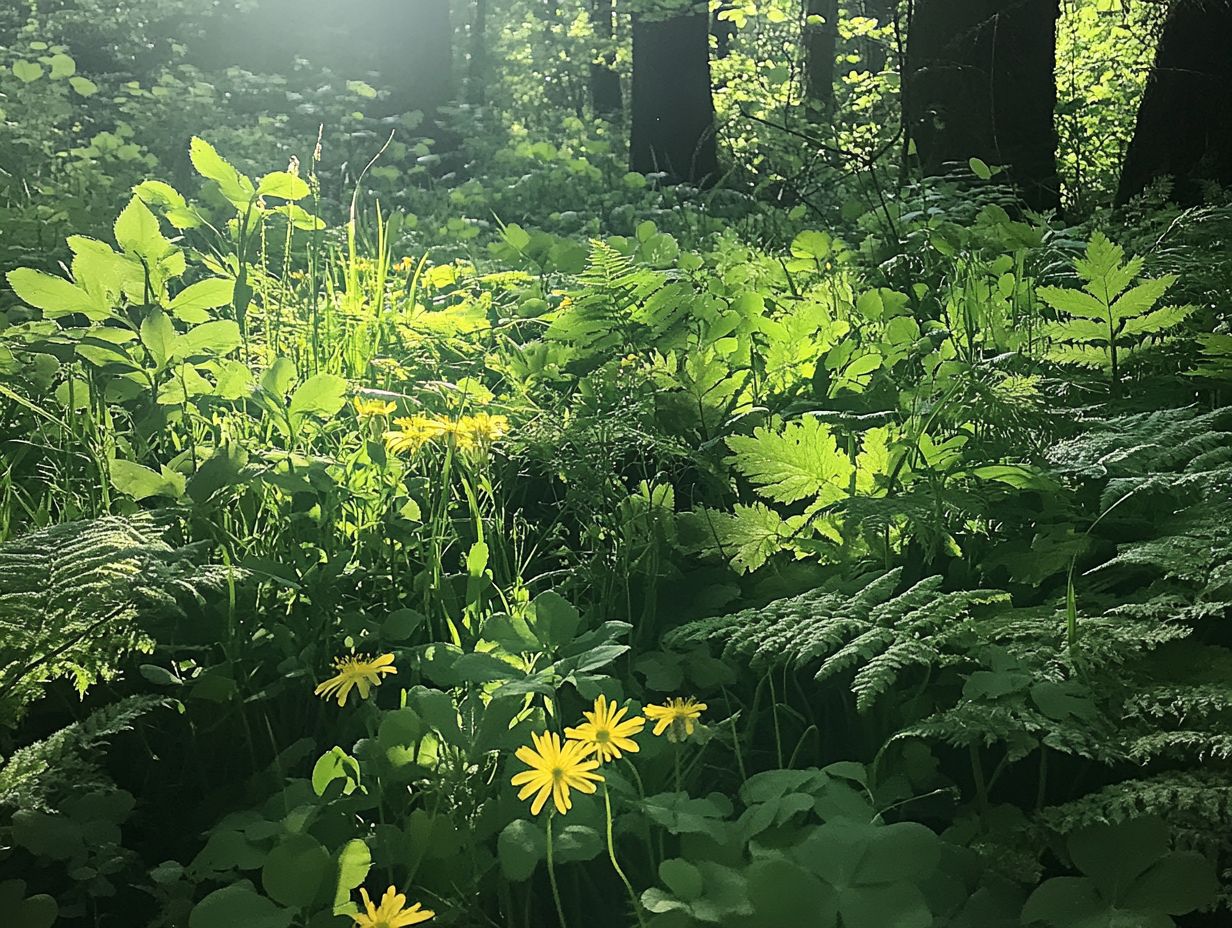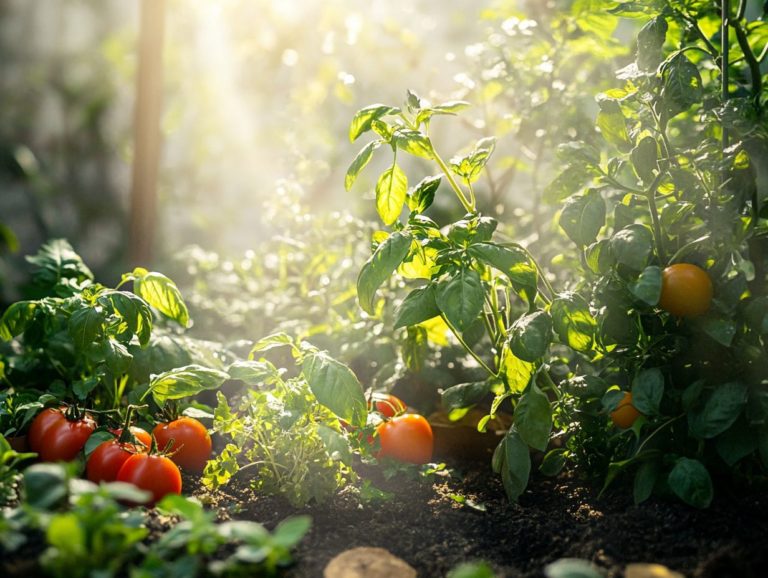The Most Nutritious Edible Plants to Forage
Foraging is a thrilling way to connect with nature while enjoying delicious, wild foods!
From pinpointing safe, wild plants to mastering the essential tools and techniques for successful foraging, this guide equips you with everything you need for your journey.
Unearth the nutritional benefits of commonly foraged plants, essential safety measures, and practical suggestions for seamlessly integrating these greens into your meals.
Whether you re just starting out or have some experience under your belt, this exploration of nature’s bounty offers valuable insights for everyone.
Contents
Key Takeaways:

- Foraging provides a variety of health benefits, including a diverse and full of nutrients diet.
- Proper identification and harvesting techniques are crucial for safely foraging edible plants.
- Foraged plants are packed with essential nutrients and can be easily incorporated into meals with proper preparation and precautions.
What is Foraging and Why is it Beneficial?
Foraging is your ticket to a world of wild edible plants, allowing you to search for, identify, and gather treasures from nature. This practice connects you intimately with your ecosystem and the community of living organisms and their environment while promoting sustainable habits. It’s an ancient skill that opens the door to an array of nutrient-rich foods and helps you discover the culinary potential of plants like wild garlic (Allium ursinum), dandelion greens, and elderflowers. To learn more about this practice, check out wild edibles to forage in winter.
In a time when food security and sustainability have never been more important, foraging lets you harvest wild plants responsibly, deepening your relationship with nature.
Historically, foraging was an essential survival technique embraced by countless cultures worldwide. The thrill of finding food in forests, meadows, and along coastlines brings an exhilarating sense of adventure. It s not just about the hunt; it s also a chance to engage in physical activity that enhances your mental well-being.
As you explore diverse environments, you’ll encounter a rich tapestry of flora, each boasting its own unique flavors and health benefits. Take nettles, for example they’re packed with vitamins A and C and can be enjoyed in delicious soups or soothing teas.
The tactile experience of gathering can be profoundly meditative, fostering mindfulness and creating a calming connection to the world around you. Embrace this journey, and let foraging enrich both your plate and your soul.
Identifying and Harvesting Safe Edible Plants
Identifying and harvesting safe edible plants is vital for anyone looking into the world of foraging. Utilizing the ultimate checklist for foraging edibles guarantees both safety and sustainability while fostering a deeper connection with nature.
By mastering the art of recognizing plants such as wild garlic, wild strawberry, and chickweed, you can responsibly gather nutrient-rich options like stinging nettle and broadleaf plantain. For those new to foraging, referring to a beginner’s guide to wild edible plants can significantly reduce the risks tied to gathering wild plants, as many can easily be confused with toxic varieties.
Tools and Techniques for Foraging
Equipping yourself with the right tools and techniques is essential for successful foraging. It enables you to gather wild edible plants efficiently and responsibly. Consider investing in sharp knives, sturdy baskets for collecting, and reliable guides that help identify safe species like wild asparagus and ramps, which are abundant in the spring.
Employing techniques such as gentle harvesting and being mindful of the ecological impact of your actions is vital for preserving wild plants like chickweed and burdock.
A sturdy digging trowel can be a game-changer when it comes to unearthing root vegetables, and a small brush will come in handy for cleaning your finds before you bring them home. Whether you prefer books or apps, foraging guides are invaluable resources for recognizing plants and steering clear of toxic varieties.
Keeping a journal can also be a great way to track seasonal changes and your favorite foraging spots.
By using these tools thoughtfully, you can savor the bounty of nature while nurturing the health of local ecosystems. Always remember to leave enough of a plant in the wild to ensure its continued growth.
Grab your basket and step into nature s grocery store today!
Common Edible Plants and Their Nutritional Value

Understanding the common edible plants available for foraging, especially in winter, and their nutritional value enriches your knowledge of wild foods. For more information, check out what edible plants can I forage in winter? It empowers you to make healthier dietary choices. Plants like wild garlic, dandelion greens, and elderflowers not only introduce unique flavors into your meals but also boast impressive nutrient profiles.
Take wild garlic, for example it serves as a delightful culinary substitute for traditional garlic, packing a potent dose of allicin, a compound known for its health benefits, that can support heart health and give your immune system a solid boost. Then there are dandelion greens, often overlooked but brimming with vitamins A, C, and K. This makes them fantastic for digestion and detoxification.
Elderflowers, with their fragrant blooms, can be transformed into refreshing syrups while offering antioxidants that may help reduce inflammation. Don t forget wild strawberries, which contribute sweetness along with essential vitamins and minerals. Chickweed provides a range of nutrients, including vitamin C and iron.
These plants are not only delicious but also good for your health.
Precautions and Safety Measures
When you embark on foraging adventures, it s essential to understand the important precautions and safety measures to ensure a safe and enjoyable experience while gathering edible plants.
By educating yourself about potential risks like misidentifying wild garlic or stumbling upon toxic plants you can significantly minimize hazards associated with wild flora.
Practicing responsible harvesting isn t just about your safety; it s also crucial for protecting the delicate ecosystems where these plants flourish.
Potential Risks and How to Avoid Them
As a forager, it’s crucial to be aware of the potential risks involved in harvesting wild edible plants. Misidentification can lead to consuming poisonous varieties. While foraging for common plants like wild garlic, dandelion greens, and wild strawberries, remember that some look-alikes, particularly those in the nightshade family, can be toxic. To enhance your foraging experience, consider learning about the top 5 edible fungi for sustainable foraging.
For effective foraging, develop a keen eye and an informed mindset. Many edible plants have deceiving look-alikes that can cause severe health issues if ingested. This highlights the importance of recognizing key characteristics like leaf shape, coloration, and growth patterns, as well as utilizing top resources for sustainable foraging to enhance your knowledge.
For example, hemlock, often mistaken for wild carrot, poses a grave threat. Therefore, conducting thorough research through reputable field guides or enrolling in foraging classes can significantly enhance your ability to differentiate between safe and harmful species.
Local botanical resources and plant identification apps can help you, promoting a safer and more rewarding foraging journey. Embrace the adventure, but proceed with care and knowledge it s your best ally in the wild.
Preparing and Incorporating Foraged Plants into Your Diet
Incorporating foraged plants into your diet can transform your culinary experience, offering you a delightful array of unique flavors and nutritional benefits.
Imagine savoring dishes enhanced by wild garlic, dandelion greens, elderflowers, and ramps. To truly appreciate these treasures, it s essential to familiarize yourself with their characteristics and cooking methods.
Whether you re crafting fresh salads, infusing oils, or experimenting with creative recipes, discovering how to weave wild plants into your everyday meals opens up a world of fun and delicious meals waiting to be explored.
So why not start foraging today? Discover the bounty of nature!
Cleaning and Cooking Methods

Proper cleaning and cooking methods are essential for getting the best taste and safety of foraged plants. They ensure the plants are perfectly primed for your culinary masterpieces.
Take wild garlic and dandelion greens, for example. A thorough wash is non-negotiable to rid them of any dirt or insects. And don t forget about stinging nettle it demands cooking to neutralize its sting before it graces your plate.
Mastering the ideal cooking techniques for each plant, like saut ing burdock or infusing oils with wild garlic, can elevate your dishes to new heights.
As you prepare these foraged delights, it’s crucial to consider their unique characteristics. Tender young lamb’s quarters, for instance, are best lightly steamed or tossed into salads. This adds a nutritious and vibrant touch to your meals.
Tougher greens like chickweed benefit from a quick boiling and then cooling, which enhances their delicate flavor without overshadowing the dish. Use this technique before folding them into stews or casseroles.
Whether you’re whipping up a wild herb pesto or a hearty roots stew, applying these specific cleaning and cooking techniques will ensure your foraged ingredients not only taste exceptional but are also safe for consumption.
Recipe Ideas and Tips for Incorporating Foraged Plants
Exploring creative recipe ideas that include foraged plants like wild garlic, elderflowers, and wild strawberries can elevate your meals while celebrating nature s bounty.
These unique ingredients invite you on culinary adventures that engage your senses and deepen your connection with the environment. Imagine blending wild garlic into a traditional pesto, infusing it with an earthy twist that beautifully complements pasta!
Or consider using elderflowers to enrich your desserts, adding a fragrant, floral note that’s perfect for cakes or ice creams.
Wild strawberries, with their intense sweetness, can transform a simple yogurt or breakfast bowl into a gourmet experience. By experimenting with these flavors, you ll discover both inspiration and joy in crafting seasonal dishes that are as nourishing as they are delightful.
Frequently Asked Questions
What are the most nutritious edible plants to forage?
The most nutritious edible plants to forage are those that are high in vitamins, minerals, and other essential nutrients. For a comprehensive list, check out the top 10 edible plants to harvest sustainably, which includes examples like dandelion greens, stinging nettle, and purslane.
Why is foraging for edible plants beneficial?

Foraging for edible plants allows you to connect with nature, save money on groceries, and access nutrient-dense foods that may not be readily available in grocery stores. To enhance your foraging experience, check out the top 10 online resources for wild edible foraging.
Can anyone forage for edible plants?
While anyone can forage for edible plants, it is important to have knowledge about plant identification and safety precautions. For those interested in winter foraging, exploring 5 edibles to keep you nourished is a great starting point. It is always best to consult with a foraging guide or expert to ensure you are gathering safe and nutritious plants.
Are all wild plants safe to eat?
No, not all wild plants are safe to eat. Some may be poisonous or have harmful effects if consumed. It is important to properly identify plants and avoid consuming anything you are unsure about.
How can I incorporate foraged edible plants into my diet?
Foraged edible plants can be used in a variety of ways, such as in salads, soups, stir-fries, or even as a replacement for other vegetables in recipes. You can also dry and store them for later use in teas or seasonings.
Are there any precautions I should take when foraging for edible plants?
Yes, it is important to forage in areas that have not been treated with pesticides or other chemicals. It is also recommended to wear gloves and wash all foraged plants thoroughly before consumption.






